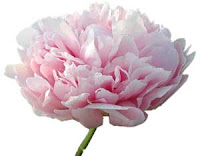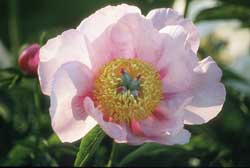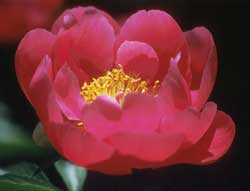By Michael Denny
In the last CPS Newsletter, an article
described the history of the Bloom Date Project and the method used to
collect data. In this issue, I will discuss recent developments and the interpretation
of the bloom date evidence.
The project has a web site (
http://peonybloomdate.com ) that
contains several articles about the project and the data. There are two data
files that contain 11,000 observations on approximately 1100 cultivars. These
files contain the same evidence. However, the difference lies in that one file
sorts by the cultivar name, while the other sorts by the bloom offset. For each
cultivar, there are columns showing the description, the observations and the
offset. The description shows the colour but this is very elemental at the moment
and so almost the only colours cited are red, white and pink. (Better cultivar
descriptions are found in other sources.)
The crucial data in this project are the
observations and the offset. The observations indicate how many inspections
have been collected on the cultivar’s bloom date. This data is an indication of
the reliability of the evidence. The offset measures how many days the cultivar
first blooms before or after the peony Red Charm. The offset data for any
cultivar varies and I report the average offset. If there are only a few
observations, the average offset may be unreliable. As more observations are
collected, the average offset may change considerably. Currently there are five or more observations
on over 600 cultivars. This is
encouraging; but it indicates that for about 500 cultivars, there are only four
or fewer observations.
One of the reasons to continue to collect data
is to increase the number of observations on those cultivars, which currently
have relatively few observations. At the moment, I still have another 1100
observations on 500 cultivars that have not been included in the web site data.
These should be added this coming winter and hopefully will push some
additional cultivars beyond the five observations threshold. Please note that you should not assume that
the information on cultivars, which have only a few observations, is wrong. The
information may be correct. However, it
is a safer indication when there have been many observations.
How to Use the Data
Individuals
should use the offset evidence with some caution. Here is how I think about
this data. Suppose I am considering
three cultivars, peony A, peony B and peony C. The offsets are 7, 9 and 2 for
peony A, peony B and peony C respectively. The offsets for cultivars A and B
are close. So, I would consider them to bloom in my garden at the same time. It
may even be that A will bloom after B in some years. However, they should bloom
at about the same time.
Cultivar C has a lower offset and the difference
is large enough that I would assume C would bloom before the other two
cultivars. It may not bloom precisely five days before the others in my garden
but it should bloom earlier.
The
basic lesson is that the detailed data can be misleading; but when used with
caution, it can be very helpful. One can easily choose cultivars that will
bloom early in their garden as well as those which will bloom very late.
To my
way of thinking, the data provides a ranked list of blooming for peony
cultivars. At any given location and in different years the time between the
blooms for any given pair of cultivars can vary. If the weather is very warm,
the time shortens; if it is mild, the time expands.
Limitations
There are definite limitations to the data in
our project. First, we are dependent on many volunteers to observe and report
data. As a result, the following problems may arise: the identification of the
cultivar may be wrong; local soil, rain and the number of hours of sunshine can
alter the information. These I cannot control.
The major limitation arises from temperature variations both between
sites and across years.
At any site, the calendar dates on which a
cultivar blooms and the time between blooming for different cultivars is
altered by temperature patterns. The use of offsets from Red Charm represents an
attempt to address this. The offset adjustment is very useful; but it is far
too simple to completely adjust for temperature variations across sites and
across the years, even at the same site.
There is no simple alternative to our adjustment. In my judgement, the
project provides us with a large volume of useful information but we just need
to be careful in its use.
Future
In recent years, there have been
discussions about the creation of a new system of bloom information based on
weeks. This would build on the detailed project information but create six
categories that would cover all the cultivars. These efforts will be put
forward in a final article in the next issue.
 Combination
peonies are being cultivated by a Nursery in Gansu Province, Northwest
China. The pictures are a combination of Japanese and Chinese tree
peonies. This nursery has been experimenting with the crosses and found
them to be very successful. They are currently trying to cultivate
crosses between Japanese and Rockii tree peonies.
Combination
peonies are being cultivated by a Nursery in Gansu Province, Northwest
China. The pictures are a combination of Japanese and Chinese tree
peonies. This nursery has been experimenting with the crosses and found
them to be very successful. They are currently trying to cultivate
crosses between Japanese and Rockii tree peonies. 































































